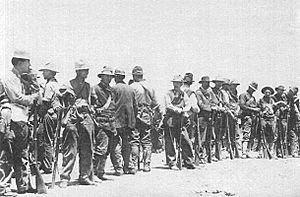Second Battle of Tijuana facts for kids
Quick facts for kids Second Battle of Tijuana |
|||||||
|---|---|---|---|---|---|---|---|
| Part of the Mexican Revolution | |||||||
 Magonistas in Tijuana after the first battle at the border town. |
|||||||
|
|||||||
| Belligerents | |||||||
|
|
|
||||||
| Commanders and leaders | |||||||
| Strength | |||||||
| 155 infantry | 360 infantry ~200 militia |
||||||
| Casualties and losses | |||||||
| ~30 killed | ~3 wounded | ||||||
The Second Battle of Tijuana was an important fight during the Mexican Revolution in June 1911. It happened near Tijuana, a city in Baja California, Mexico. The battle was between a rebel group called the Magonistas and the Mexican federal army. The federal army also had help from American volunteers. After a short fight, the federal forces won and took back control of Tijuana.
Contents
Why the Battle Happened
The Magonista campaign in Baja California started on January 29, 1911. Their first big action was taking over Mexicali. After that, the rebels split into two groups. One group, led by Caryl ap Rhys Pryce, marched towards Tijuana.
Magonistas' Goals and Challenges
The main goal of the Magonista leaders was to capture Ensenada. They wanted to create a new kind of government there, where everyone shared resources. However, the Magonista leader, Ricardo Flores Magon, spent money on spreading his ideas instead of buying supplies for his fighters.
Many Magonista fighters were from the United States. This made it hard for them to get support from the local people in Baja California. The Magonista army also had problems with different groups of people not getting along.
The Armies Gather
The Magonistas' first group in Mexicali gave up on June 17. This happened after Francisco I. Madero, another rebel leader who was about to become president, offered peace. So, Madero's rebel troops then became part of the official Mexican Army.
At this time, the Magonista group near Tijuana was led by John R. Mosby. He was a former United States Marine. His force had about 155 men. Many of them were members of a group called the Industrial Workers of the World from California.
The Mexican federal forces were led by Colonel Celso Vega. He had 360 soldiers and over 200 armed Mexican volunteers. They arrived by ship at Ensenada and then marched north towards Tijuana. Colonel Vega's forces also had six machine guns and some artillery.
On June 22, 1911, John Mosby marched his men to meet Vega's force just south of Tijuana.
The Battle of Tijuana
When John R. Mosby heard that Vega's men were in the hills east of Tijuana, he ordered his Magonista group to attack. Since most of his fighters were on foot, they used a work train to move quickly. This train was a steam locomotive taken from the San Diego and Arizona Railway.
Fighting Begins
The Magonistas were outnumbered and not well protected. The federal forces began firing machine guns and artillery from higher ground. The federal soldiers kept their distance, so most of the battle was fought from far away.
Rebels Retreat
Near the end of the battle, the federal army launched a big attack on the Magonistas' sides. General Mosby's force was defeated. The American Magonistas ran north towards the U.S. border. Some even used the train to escape. At 1 PM, they gave up to Captain Evans of the United States Army at the border.
The Mexican Magonistas, including some Native Americans, escaped into the countryside. Reports about how many people died or were hurt are different. Some say only a few federal troops were wounded. Other reports suggest more federal soldiers were killed or wounded. The Magonistas lost over thirty men, and most of their bodies were left on the battlefield.
What Happened Next
The Second Battle of Tijuana ended the Magonista rebellion in Baja California. After the battle, Ricardo Flores Magon was arrested in 1918. He was put in prison and died there in 1922. Today, Magon is seen as a hero in Mexico.
After this battle, there were only a few small attacks by American Magonistas. These attacks came from California and stopped by 1915. Because of the rebel activity, the Mexican government built Fort Tijuana. It was a large, square fortress to protect the border.

